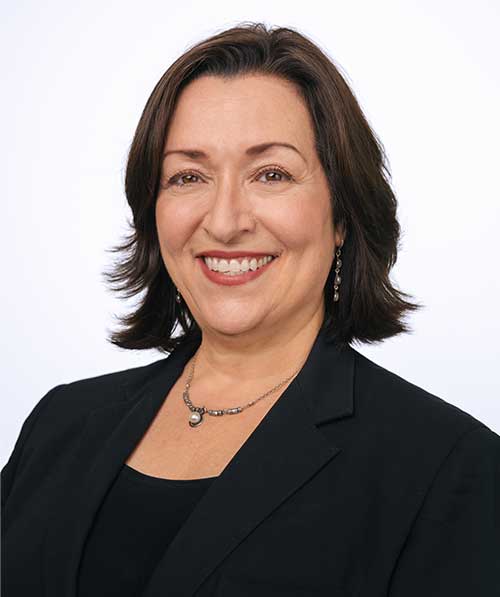 Marlene Puffer
Marlene Puffer Chief Investment Officer, Alberta Investment Management Corporation (AIMCo)
A major shift is underway at Alberta Investment Management Corporation. The provincially-owned investment manager has commenced a comprehensive overhaul of systems that will support ‘total portfolio management’ for each of the institution’s clients, clarify performance attribution, enhance understanding of risk exposures, and much more. “It’s rather like trying to replace the engine of a plane while it’s still in the air,” says CIO Marlene Puffer, who recently sat down with bfinance Investor Spotlight to discuss the developments.
Moreover, this is not just any plane. AIMCo is a Superjumbo jet in terms of its size and complexity: its 700+ staff manage CAD 168 billion for 17 underlying government, pension, endowment, insurance and other clients (themselves representing nearly 30 bodies of assets), deploying capital through its roster of asset-class-specific pools while also trying to deliver value through tactical tilts and effective capital allocation.
It is the kind of challenge that Puffer, who stepped into her role in January 2023, relishes. “What really interests me is solving problems,” she explains, reflecting on her own extensive and storied career – helping to pioneer asset-liability management in Canada, working on the committee tasked with restructuring asset-backed paper following the GFC and de-risking NAV Canada’s pension plan, to name a few. Before her AIMCo appointment, she held senior positions at CN Investment Division (CEO), HOOPP (Vice Chair of the Board) and so forth. “Many people in roles like this will say they like building something and that’s great, of course. But for me it’s about having a problem and finding a way to solve it… That’s where I feel I can make an impact.”
Below, we share selected insights from Puffer on several attention-worthy developments, including improving the ‘capital allocation engine’ in private markets, clarifying overall exposures to climate and artificial intelligence themes, the aforementioned move towards ‘total portfolio management’ and fostering a more collaborative leadership culture.
CHANGES IN FOCUS: TOTAL PORTFOLIO MANAGEMENT AND MORE
Marlene Puffer on executive team overhaul
I feel like I took on this role at a really interesting time. AIMCo had considerable losses in March 2020 and the executive team has entirely changed since then. There was a need to move towards more of a multi-client approach, but AIMCo was essentially built in the image of OTPP [single client]. There was a need for a step-up in institutionalisation. Developments on the risk side were already underway when I joined: Suzanne Akers [CRO] joined nine months before I did. We had a strong CEO in place [Evan Siddal, CEO since July 2021]. Both Theresa Whitmarsh [former CEO of SWIB] and Jim Keohane [former CEO of HOOPP] had just joined the board, with Mark Wiseman still chairing, and a strong board is instrumental to ensuring success at a time like this. We’ve also brought in a new leader for the total portfolio management function—Kevin Bong from GIC [hired as Chief Investment Strategist and Head of Singapore, May 2023].
On ‘total portfolio management’ versus ‘total fund management’
There are two ways we think about this. One is about ‘total fund management’ at the level of the pooled assets. The other is ‘total portfolio management’ client by client: this is a key focus for us; we want each client to have detailed information on their portfolio and their risk exposures, helping them to understand and make decisions about their long-term asset mix.
We have a substantial fiduciary management team that works with each client, offering asset-liability advice, monitoring each client’s positions. The transformation of our systems will be a game changer for this, offering portfolio analytics and risk insights, therefore allowing us to answer questions consistently, clearly, and quickly. The investment management teams themselves are not explicitly client facing but the asset class teams do have close relationships with clients’ management teams and boards; they spend time with them, they present to them.
[At the ‘total fund management level] we want to benefit as much as possible from economies of scale. We’re working on redesigning our product line-up [a pool for each asset class]. We also want to break down silos between asset classes, and facilitate greater execution together, particularly in areas such as derivatives and collateral management.
On building a better capital allocation engine and the challenge in private markets
We’re working on building a stronger capital allocation engine. This is about thinking where we are in terms of allocations relative to the desired level [client allocations + any desired AIMCo tilt] and how we get where we want to be.
Putting money to work is much easier when you’re looking to grow a private markets portfolio, but once you’re at—or near—the target level, you have to think more carefully.It is particularly difficult in private markets now that we are at or near the target allocation. Putting money to work is much easier when you’re looking to grow a private markets portfolio, but once you’re at—or near—the target level, you have to think more carefully about the balance between ‘money out’ and ‘money in’. We have to put that marginal dollar to work. You have to make assumptions on risk and return for each asset class in order to support that [capital allocation engine]. You have to make decisions on where you should be overweight and underweight. It’s particularly tricky in private debt, since you need to [recycle capital] more frequently.
We’re also trying to get more nuanced on the tactical asset allocation side of things, and thinking about how we get information to feed those tilts. We have significant discretion to tilt around clients’ target long-term asset mix. This is being supported by an improving understanding of the risk exposures across the portfolio, including in private markets (which contain equity and bond-type risk exposures).
On investing in climate and artificial intelligence
We’re starting to refine our approach on climate and AI data centres; the power generation required to run artificial intelligence; renewable energy and the supply chain surrounding this space. We realise that we have exposure to this theme through many different parts of the portfolio: private markets, equities, even mortgages. There’s a lot of crossover: in private markets, for example, you could be investing in a company whose main client is one of the big listed tech firms.
It’s important to consider how much exposure you actually want… Rather than finding yourself making the same bets through your different asset classesWe think it’s important to consider how much exposure you actually want and which types of exposure are more attractive than others, rather than finding yourself making the same bets through your different asset classes. For example, if the opportunity is more attractive on the private debt side than the private equity side then that’s where you want to focus: it shouldn’t just be about each team beating their own hurdle rate.
On changes in the Real Estate and Private Debt pools
In Real Estate, we’ve been shifting our strategy and the structure of the team. The portfolio has been quite challenged over the past couple of years. We’ve restructured the team so that it now has three heads: a head overseeing new investments, a head responsible for managing what we already own and a head of analytics. This helps to ensure focus on not just new investments, but on the management of existing assets, which may increasingly include making dispositions. We’re putting new capital to work particularly in niche areas – UK Rental, Multi-family in Europe and North America, Grocery-anchored Retail.
In Private Debt, we’re still growing the portfolio: it was at CAD 2 billion five years ago; now it’s around CAD 7 billion and we’re aiming for about CAD 9 billion. We’ve set up a New York office to support activity in the large cap space – we’re increasingly focusing on this area as the portfolio grows in size (we do some fund investment but aim to do multiples of that figure in co-investment, so large cap exposure makes a lot of sense for us). We have also been developing our strategic partnerships. Where an asset manager does both private debt and private equity, we like them to deal with us in a non-siloed way (another ‘silo-smasher’ for us).
On culture, leadership and diversity
We are working to change the culture of the organisation and break down silos. A significant percentage of the total compensation of senior leaders is based on the performance of the total portfolio. It’s not just about you and your deal. We also provide good leadership training opportunities. We’re focused on innovation – we want a ‘fail-fast’ mentality and an attitude of experimentation. DEI is a big part of my work. Overall, in my view, the industry has focused perhaps too much on hiring from a group of business schools, hiring people with quite similar educations, training deal-makers. But diversity of thought is a huge advantage. Every team, for example, might benefit from having someone from an arts background. You want people who think differently, who think about the relationships between things in a different way.
Important Notices
This commentary is for institutional investors classified as Professional Clients as per FCA handbook rules COBS 3.5R. It does not constitute investment research, a financial promotion or a recommendation of any instrument, strategy or provider. The accuracy of information obtained from third parties has not been independently verified. Opinions not guarantees: the findings and opinions expressed herein are the intellectual property of bfinance and are subject to change; they are not intended to convey any guarantees as to the future performance of the investment products, asset classes, or capital markets discussed. The value of investments can go down as well as up.


 English (Global)
English (Global)  Français (France)
Français (France)  Deutsch (DACH)
Deutsch (DACH)  Italiano (Italia)
Italiano (Italia)  Dutch (Nederlands)
Dutch (Nederlands)  English (United States)
English (United States)  French (Canada)
French (Canada) 

